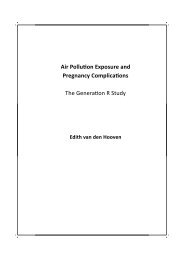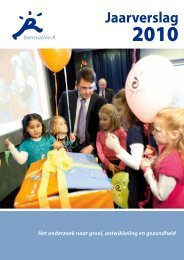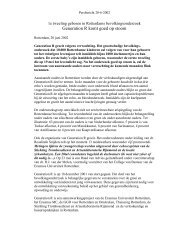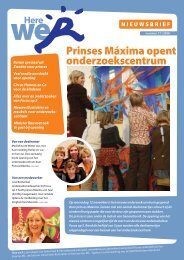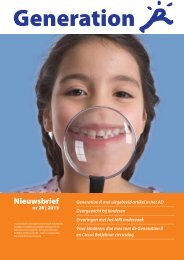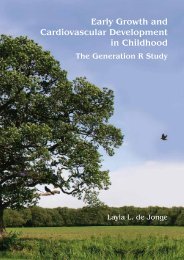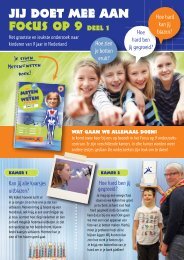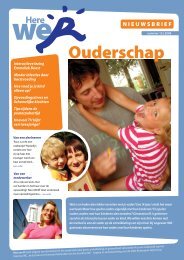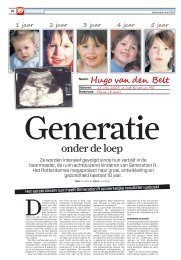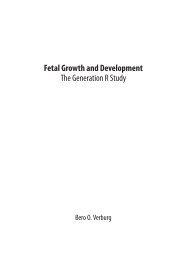Parents and infants: determinants of attachment in a ... - Generation R
Parents and infants: determinants of attachment in a ... - Generation R
Parents and infants: determinants of attachment in a ... - Generation R
Create successful ePaper yourself
Turn your PDF publications into a flip-book with our unique Google optimized e-Paper software.
Attachment, depression, <strong>and</strong> cortisol: Deviant patterns <strong>in</strong> <strong>in</strong>secure-resistant <strong>and</strong> disorganized <strong><strong>in</strong>fants</strong><br />
<strong>in</strong>fant, <strong>and</strong> the parent leav<strong>in</strong>g the room twice (see A<strong>in</strong>sworth et al., 1978, for<br />
the protocol). The SSP used <strong>in</strong> the current study <strong>in</strong>cluded all these stimuli<br />
but to make it fit <strong>in</strong>to a tight time schedule, we shortened the (pre-)separation<br />
episodes with one m<strong>in</strong>ute keep<strong>in</strong>g the critical reunion episodes <strong>in</strong>tact.<br />
Attachment behavior was coded from DVD-record<strong>in</strong>gs accord<strong>in</strong>g to the<br />
A<strong>in</strong>sworth et al. (1978) <strong>and</strong> Ma<strong>in</strong> <strong>and</strong> Solomon (1990) cod<strong>in</strong>g systems by two<br />
reliable coders, tra<strong>in</strong>ed at the University <strong>of</strong> M<strong>in</strong>nesota. Inter-coder agreement<br />
was calculated on 70 SSPs that were coded by both coders. For ABCD classification,<br />
<strong>in</strong>ter-coder agreement was 77% ( = .63); agreement on disorganization<br />
was 87% ( = .64). Of all cases, 8% were discussed with one <strong>of</strong> two<br />
expert coders <strong>and</strong> classification was assigned after consensus was reached.<br />
Salivary cortisol: diurnal rhythm <strong>and</strong> stress reactivity. Prior to the 14 months<br />
visit <strong>of</strong> the <strong>Generation</strong> R Focus Study parents were asked to collect saliva<br />
samples from their child at home us<strong>in</strong>g Salivette sampl<strong>in</strong>g devices (Sarstedt,<br />
Rommelsdorf, Germany). <strong>Parents</strong> received detailed written <strong>in</strong>structions<br />
with pictures concern<strong>in</strong>g the saliva sampl<strong>in</strong>g. They were asked to collect<br />
five saliva samples dur<strong>in</strong>g one s<strong>in</strong>gle weekday at home: immediately after<br />
awaken<strong>in</strong>g, 30 m<strong>in</strong>utes later, between 11 am <strong>and</strong> 12 pm, between 3 <strong>and</strong> 4<br />
pm, <strong>and</strong> at bedtime; <strong>and</strong> to note down the sampl<strong>in</strong>g times. The child was<br />
supposed not to eat or dr<strong>in</strong>k 30 m<strong>in</strong>utes before each sampl<strong>in</strong>g. The children<br />
were otherwise free to follow their normal daily rout<strong>in</strong>es on the sampl<strong>in</strong>g<br />
day. <strong>Parents</strong> were asked to keep the samples stored <strong>in</strong> a freezer until they<br />
visited the research centre. If parents forgot to br<strong>in</strong>g the samples, they were<br />
asked to send the Salivettes by postal mail. For 397 children (55%) one or<br />
more home saliva samples were returned. One child was excluded because<br />
he/she was older than 20 months. To compute a cortisol composite measure,<br />
at least the first sample <strong>and</strong>, depend<strong>in</strong>g on the measure, one or two subsequent<br />
samples had to be obta<strong>in</strong>ed, which left 363 children for the diurnal<br />
assessments. None <strong>of</strong> the children used systemic corticosteroid medication,<br />
but 12 children used other corticosteroid-conta<strong>in</strong><strong>in</strong>g medication. Exclud<strong>in</strong>g<br />
these children did not change the results, so they were <strong>in</strong>cluded <strong>in</strong> further<br />
analyses. Dur<strong>in</strong>g the visit at the research centre at 14 months <strong>of</strong> age, three<br />
saliva samples were taken; the first prior to the SSP, the second directly after<br />
the SSP (which was on average 10 m<strong>in</strong>utes after the first separation <strong>of</strong> the<br />
SSP) <strong>and</strong> the third about 15 m<strong>in</strong>utes later (M = 16.3, SD = 8.3). For 369 children<br />
(51%) three samples were obta<strong>in</strong>ed.<br />
Samples were centrifuged <strong>and</strong> frozen at -80°C. After completion <strong>of</strong> the<br />
data collection, all samples were sent <strong>in</strong> one batch (frozen, by courier) to<br />
the Kirschbaum laboratory (Technical University <strong>of</strong> Dresden, Biological<br />
<br />
91



